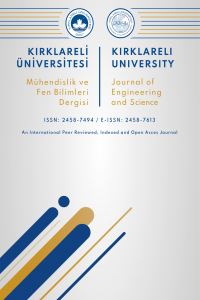TEMEL İNCE FİLM ÜRETİM TEKNİKLERİNE BİR BAKIŞ
Malzeme bilimi ve teknolojilerinin gelişmesi daha kaliteli, sağlam ve dayanıklı malzemelerin üretilmesine imkân sağlamıştır. Bu gelişmelerin temelinde ince filmlerin yaygın olarak kullanılması ve ince film üretim teknolojilerinin gelişmesi etkili olmuştur. İnce film üretim teknikleri akademik araştırmalarda, teknolojik uygulamalarda ve birçok endüstriyel faaliyette yaygın olarak kullanılmaktadır. Hazırladığımız çalışmamızda temel ince film üretim teknikleri incelenmiş, ince film üretiminde kullanılan her bir temel tekniğin sahip olduğu avantajlar ve dezavantajlar tartışılmış ve ince filmlerin potansiyel uygulama alanlarına değinilmiştir.
Anahtar Kelimeler:
İnce Filmler, Fiziksel Buhar Kaplama, Kimyasal Buhar Kaplama, ; DC sıçratma, Elektrodepozisyon
A Glimpse to the Essential Thin Film Production Techniques
Advancements in materials science and technologies enable us to produce more durable, stronger materials of high quality. Developments in thin film technologies play an important role in achieving such an advancement. Thin films are commonly used in research, technological applications, and various industrial activities. In this work, essential thin film production techniques were investigated; the advantages and disadvantages of each essential technique were discussed, and potential industrial and technological applications were mentioned.
Keywords:
Thin Films, Physical Vapour Deposition, Chemical Vapour Deposition, DC Sputtering, Electrodeposition,
___
- W. F. Smith (1986), Principles of Materials Science and Engineering, McGraw Hill Book Co., New York.
- A. Goswami, Thin Film Fundamentals (New Age International, New Delhi, n.d.).
- L. Vossen J and W. Kern (1991), Thin Film Processes II , 1st ed., Academic Press, San Diego.
- S. Zhang and D. Zhao (2013), Aerospace Materials Handbook , 1st ed., CRC Press, Florida.
- P. Louda, J. Achiev. Mater. 24, 50 (2007).
- N. Aslan, M. Ş. Kurt, and M. Mehmet Koç (2022), Opt. Mater. (Amst). 126, 112229.
- F. Yakuphanoglu and W. A. Farooq (2011), Synth. Met. 161, 379.
- N. Aslan, B. Aksakal, B. Dikici, and Z. A. Sinirlioglu (2022), J. Mater. Sci. 57, 16858.
- J. I. Ahuir-Torres (2023), J. Mater. Electron. DEVICES 1, 33.
- J. I. Ahuir-Torres and M. C. Sharp (2022), Lasers Manuf. Mater. Process. 9, 454.
- N. Yamamoto, H. Makino, T. Yamada, Y. Hirashima, H. Iwaoka, T. Ito, A. Ujihara, H. Hokari, H. Morita, and T. Yamamoto (2010), J. Electrochem. Soc. 157, J13.
- S. Niyomsoan, W. Grant, D. L. Olson, and B. Mishra (2002), Thin Solid Films 415, 187.
- H. Frey (2015) in Handb. Thin-Film Technol., Springer Berlin Heidelberg, Berlin, Heidelberg, pp. 1–3.
- L. Smardz, U. Köbler, and W. Zinn (1991), Vacuum 42, 283.
- C. Shi, Z. Chen, G. Shi, R. Sun, X. Zhan, and X. Shen, (2012), Thin Solid Films 520, 4898.
- K. Reichelt and X. Jiang, (1990), Thin Solid Films 191, 91.
- J. A. Greer (2013), J. Phys. D. Appl. Phys. 47, 034005.
- J. Vyskočil and J. Musil (1990), Surf. Coatings Technol. 43–44, 299.
- G. Bräuer, B. Szyszka, M. Vergöhl, and R. Bandorf (2010), Vacuum 84, 1354.
- T. K. Subramanyam, B. Srinivasulu Naidu, and S. Uthanna (2001), Appl. Surf. Sci. 169–170, 529.
- J. O. Carlsson and P. M. Martin (2010), in Handb. Depos. Technol. Film. Coatings Sci. Appl. Technol., William Andrew Publishing, pp. 314–363.
- D. H. Chen and X. R. He (2011), Mater. Res. Bull. 36, 1369.
- R. G. Larson and T. J. Rehg (1997), in Liq. Film Coat., Springer, Dordrecht, pp. 709–734.
- G. Oskam, J. G. Long, A. Natarajan, and P. C. Searson, J.(1998), Phys. D. Appl. Phys. 31, 1927.
- ISSN: 2458-7494
- Yayın Aralığı: Yılda 2 Sayı
- Başlangıç: 2015
- Yayıncı: Kırklareli Üniversitesi
Sayıdaki Diğer Makaleler
DERİN ZEMİN KARIŞTIRMA YÖNTEMİYLE İYİLEŞTİRİLEN ORGANİK ZEMİNLERİN DAYINIMI
Hossein ZORİYEH ALİGHOLİ, Prof. Dr. İlknur BOZBEY
SÜRDÜRÜLEBİLİR İNŞAAT SEKTÖRÜ İÇİN GERİ DÖNÜŞÜM BETON AGREGASI
Onur YAVAN, Prof. Dr. İlknur BOZBEY
TEMEL İNCE FİLM ÜRETİM TEKNİKLERİNE BİR BAKIŞ
Erdal KARAKUŞ, Mümin Mehmet KOÇ
Al/p-Si/CuPc/Al FOTODIYOTLARIN FOTOVOLTAIK İNCELENMESI
Zöhre GÖRÜNMEZ GÜNGÖR, Burhan COŞKUN, Mustafa İLHAN, Mümin Mehmet KOÇ
DOĞAL GAZIN GÜVENLİ KULLANIMINDA PERİYODİK KONTROLLERİN ETKİSİNİN ARAŞTIRILMASI
HARDALİYE ÜRETİM SÜRECİ VE SÜRECİ ETKİLEYEN FAKTÖRLERİN KALİTE ÜZERİNE ETKİLERİ
